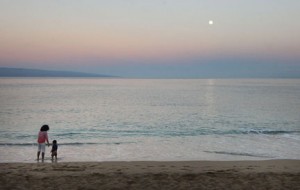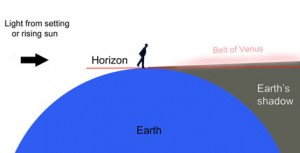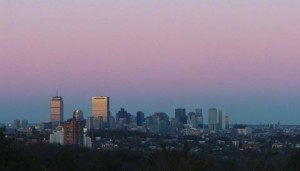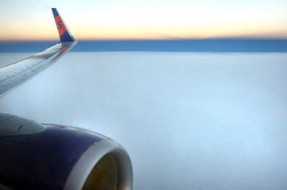The next time you're out watching a sunset, turn around and relish the mighty shadow of Earth looming just behind your back.

Bob King
Here's a riddle. What sets when the Sun rises and rises when the Sun sets?
If you guessed Earth's shadow, give yourself a pat on the back. Strangely, it might be the most common but widely ignored phenomenon of the twilight sky.
I suspect most people have seen the purple-gray band of shadow that grows along the eastern horizon after sunset on clear evenings but dismissed it as clouds or haze. In one sense, the shadow resembles an approaching storm, a dark presence rising in the east that slowly overtakes the fading blue twilight until overtaken itself by night.

Bob King
To see a shadow it must be cast on something. When it comes to a whole planet, the only thing big enough close to home is the atmosphere itself. Find a location with a wide open to the east at sunset (or west starting about 30 minutes before sunrise) and look for a blue-gray band rimming the horizon directly opposite the sunset. Sweep your gaze along the nearly 180° arc for a visceral feel of Earth's true girth.
A delicate rosy glow called the Belt of Venus caps the shadow along its length. Although we might never know who first coined the term, it likely refers to the alluring, magical breast band worn by that famous Greek goddess. Also known as the anti-twilight arch, it's formed when reddened sunlight is scattered back to our eyes by air higher up still touched by the low Sun.

J. Kelly Beatty
A few minutes may suffice to appreciate our planet's form hanging in thin air, but spend 20 minutes and you'll see the full story unfold.
When the Sun is just 2° below the horizon (about 8 to 10 minutes after sunset) the shadow hovers low along the eastern horizon. Because our gaze penetrates the hazy air of the lower atmosphere nearly edge-on at this time, the edge of the shadow is more distinct. This is also when the Belt of Venus is brightest and most colorful.
By the time the Sun dips to –5°, not only has the shadow climbed steadily higher, it's grown more diffuse and the belt has begun to fade. Some 25 minutes after sunset, the shadow blends into the deepening blue of twilight and disappears.

Bob King (left), NASA
Sometimes you'll see a crown of blue and pink beams converging atop the rising shadow. These are anti-crepuscular rays. Their cousins, crepuscular rays, form when sunbeams shine through gaps in towering clouds to create a spreading fan of sunbeams and shadows. Under the right conditions, patchy clouds below the observer's sunset horizon can create crepuscular rays that extend all the way to the opposite end of the sky as anti-crepuscular rays. Watch for them.

Bob King
If you want to see Earth's shadow at its most dramatic, get a window seat on your next airplane flight. Last month, by pure luck I ended up sitting on the left side of the plane as we flew southwest over the sunset hour. Seen from the clean, dry air at 35,000 feet, the shadow appeared ominously dark purple with a much sharper edge than ground dwellers are accustomed to seeing.
Part of the enhanced contrast undoubtedly came from seeing the shadow edge-on with all the haze and aerosols in the lower atmosphere stacked across a vast horizontal distance — perfect for shadow-casting! But I wonder if the raw transparency of rarefied air at high altitude may also have been a factor. If you've never seen our planet's shadow from an airplane, plan your seating well. Or get lucky. Either way you'll be wowed.
Track all the year's celestial highlights with our annual Skygazer's Almanac.
 4
4








Comments
Eric Vandernoot
August 1, 2014 at 6:02 pm
Thanks Bob for writing this article. This effect is very noticeable down here in South Florida and this part of the state coastline is parallel to lines of longitude. My personal favorite way of describing it to our students is to call it the "edge of night".
You must be logged in to post a comment.
Alexander Vasenin
August 4, 2014 at 12:31 am
Hi Bob,
There is an app to calculate time and direction of the inflight sunset (disclaimer: I'm the developer)
You must be logged in to post a comment.
August 4, 2014 at 9:26 am
Thanks for the nice article on this, I help conduct observing sessions at Observatory Park in Great Falls, Virginia a on Friday nights and point out earth's shadow when it is visible. You are right, there are many sunrise and sunset phenomena people can enjoy, and now I can refer them to your article.
You must be logged in to post a comment.
Peter Wilson
August 4, 2014 at 10:30 am
Great picture of anti-crepuscular rays!
You must be logged in to post a comment.
You must be logged in to post a comment.